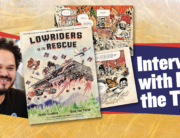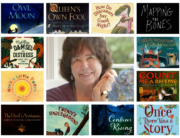Imagine a suitcase.
It’s old, journey-weathered, and has lived in a lonely corner of a relative’s attic for more than fifty years. You recognize the name on the dusty tag. It belonged to your grandparents or your great-grandparents. What do you hope is inside?
For the past decade, I’ve been traveling the world in search of history because I am absolutely convinced that the most moving and incredible stories remain untold. I’ve opened hundreds of suitcases and listened to extraordinary narratives. Each journey, event, and suitcase leads me to the same conclusions:
Every human being has a story to tell.
Every adult wishes they had recorded or preserved their ancestors’ story.
Every discussion of the past leads us back to our own personal, family history.
Some stories hide in dark corners, covered by fear or shame. Others live in broad daylight, walking among us, convinced they are uninteresting.
They are always interesting.
Interpretations of Story
My fascination with family narrative fuels my dedication to historical fiction. My historical novels, Between Shades of Gray, Out of the Easy, and Salt to the Sea are collectively published in over fifty countries and forty languages. The merit belongs not to me, but to the translators who have worked so painstakingly to interpret my stories into languages that for me are locked doors.
Just as each suitcase and country are different, so are the interpretations of story.
Teachers in the United States use my novels to explore themes of journey and survival. In France, however, I’m told the theme of my work is identity—how much can be taken away from a human being before we lose our identity? Is it possible to lose our sense of self?
In many countries, there are questions of responsibility. In Asia and the East, the discussions are of collective shame vs. honor—how the history affects the family, the village, the nation. In the West, the discussions lean more autonomous—guilty vs. innocent and the role each individual plays in history.
But regardless of the country, the path of conversation eventually winds back to the reader’s personal story. In Tarragona, Spain, a high school presented me with a “Virtual Suitcase” exhibit. The teachers challenged their students to photograph what they would pack if they were deported or forced to flee their country.

The students’ photographs reflected not only their interpretation of the novel’s story and history, but also their own story. The pictures spoke of their passions and heart, what was precious to them and what they were desperate to preserve.


One student in Tarragona placed just a single item in her suitcase—her mother.

Hunting for History
While researching my latest novel, Salt to the Sea, I opened suitcases in six different countries. The book tells the story of the refugee evacuation at the end of World War II and the largest maritime disaster in history—the sinking of the Wilhelm Gustloff. Ten thousand desperate refugees boarded a ship with capacity for only fourteen hundred. The passengers dreamed of family and freedom. But waiting in the depths of the Baltic Sea was a Soviet submarine. Three torpedoes killed over nine thousand people, including five thousand innocent teenagers and children. The death toll of the Wilhelm Gustloff dwarfs the Titanic and the Lusitania combined, but most of the world has never heard of it. Over twenty-five thousand suitcases lay in a cold graveyard at the bottom of the Baltic Sea.
Deep-sea divers who explored the sunken ship recreated the tragedy vividly for me. Two Polish divers who were early explorers, described the enormous swath of personal belongings strewn for miles on the seabed surrounding the sunken Gustloff. The divers swam through the population and possessions of an annihilated city. They mentioned countless shoes, a porcelain vase full of scarves, a chipped teacup, a typewriter, a sterling baby rattle, a military belt cradling a weapon, and thousands of suitcases strewn for miles on the sandy sea floor surrounding the wreck. To the divers, each item and piece of luggage represented a different story.
Each person I interviewed had a different interpretation and explanation of the episode and time period. That’s natural. We all interpret history through our own personal lens. Just like the students in Tarragona, we all carry different suitcases, packed with different stories.
Suitcases of the Future
When I visit schools around the world and the conversations turn from global history to personal history, the mourning is rarely for material possessions. The mourning is for loss of story. If an old suitcase is discovered, the desired contents are truth, details. Material items and photographs have no context without an accompanying narrative. As I entered the school in Tarragona, I was guided through a “Hall of Silence.” Hanging from the ceiling were pictures of the students’ relatives. Photos were chosen specifically of departed family members whose stories were lost or remain untold.

Yes, history has a way of hiding. But if we are our history, both individually and collectively, do we not owe it to ourselves and our families to search for it? Isn’t it our shared threads of human experience that connect us? I’m so grateful to educators, like the teachers in Tarragona, who incorporate memory preservation exercises into their curriculum. The “Hall of Silence” led the students to wonder and ask questions. Simple questions lead to discovery of lost threads that when woven together may patch a hole. A recorded interview with a relative today might explain the contents of a suitcase discovered far into the future.
If you could find or preserve one story, what would it be and how would you do it? This holiday season when you see your family members, take time to ask questions. Listen. Jot down notes. Record. Preserve. Knowledge of personal history deepens our sense of self, strengthens family bonds, and gives us framework through which to understand and interpret the past when we discover it in the future.
Give it some thought. What’s in your suitcase?








Leave A Comment